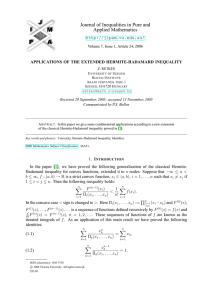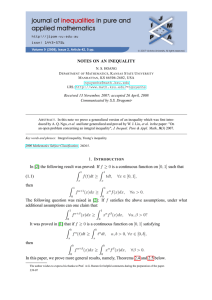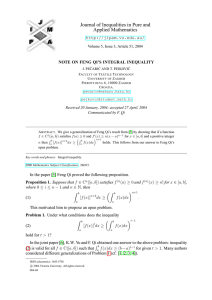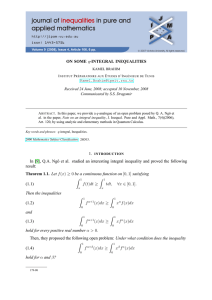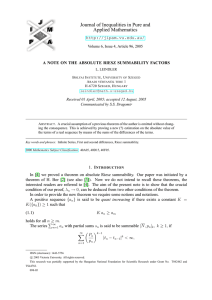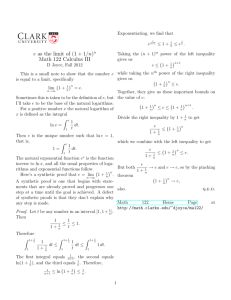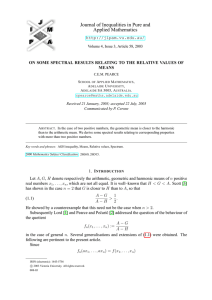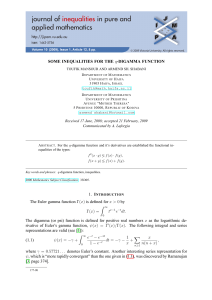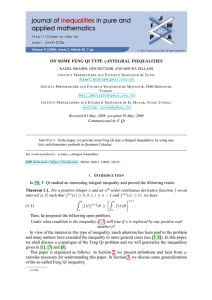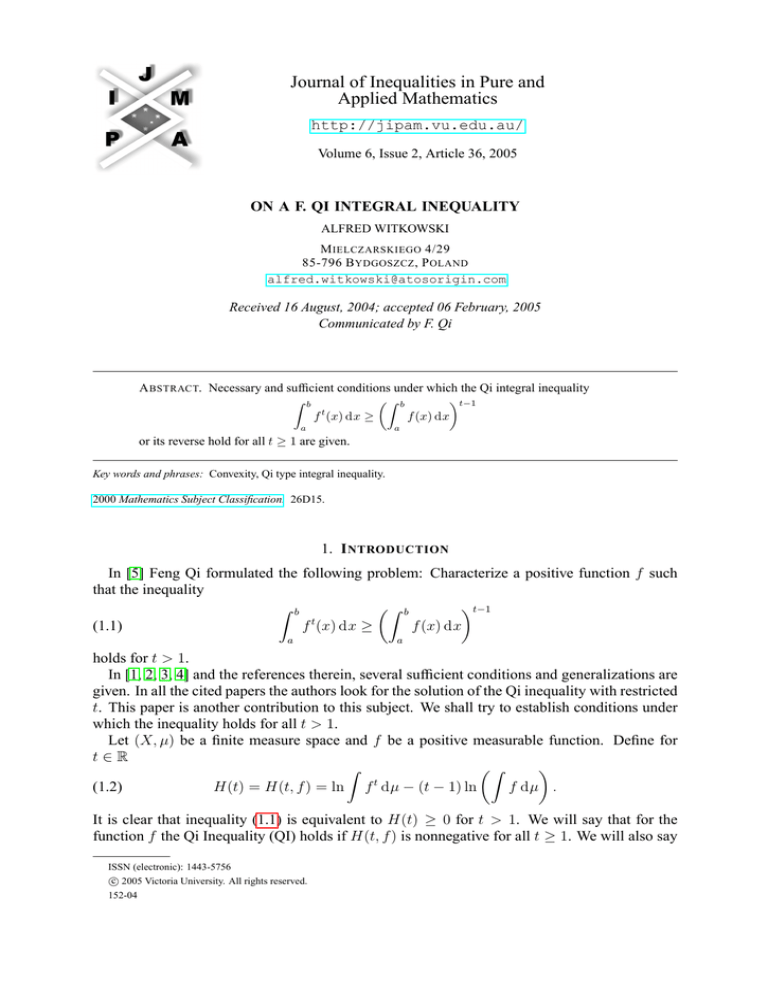
Journal of Inequalities in Pure and
Applied Mathematics
http://jipam.vu.edu.au/
Volume 6, Issue 2, Article 36, 2005
ON A F. QI INTEGRAL INEQUALITY
ALFRED WITKOWSKI
M IELCZARSKIEGO 4/29
85-796 B YDGOSZCZ , P OLAND
alfred.witkowski@atosorigin.com
Received 16 August, 2004; accepted 06 February, 2005
Communicated by F. Qi
A BSTRACT. Necessary and sufficient conditions under which the Qi integral inequality
Z b
t−1
Z b
f t (x) dx ≥
f (x) dx
a
a
or its reverse hold for all t ≥ 1 are given.
Key words and phrases: Convexity, Qi type integral inequality.
2000 Mathematics Subject Classification. 26D15.
1. I NTRODUCTION
In [5] Feng Qi formulated the following problem: Characterize a positive function f such
that the inequality
Z b
t−1
Z b
t
(1.1)
f (x) dx ≥
f (x) dx
a
a
holds for t > 1.
In [1, 2, 3, 4] and the references therein, several sufficient conditions and generalizations are
given. In all the cited papers the authors look for the solution of the Qi inequality with restricted
t. This paper is another contribution to this subject. We shall try to establish conditions under
which the inequality holds for all t > 1.
Let (X, µ) be a finite measure space and f be a positive measurable function. Define for
t∈R
Z
Z
t
(1.2)
H(t) = H(t, f ) = ln f dµ − (t − 1) ln
f dµ .
It is clear that inequality (1.1) is equivalent to H(t) ≥ 0 for t > 1. We will say that for the
function f the Qi Inequality (QI) holds if H(t, f ) is nonnegative for all t ≥ 1. We will also say
ISSN (electronic): 1443-5756
c 2005 Victoria University. All rights reserved.
152-04
2
A. W ITKOWSKI
that for the function f the Reverse Qi Inequality (RQI) holds if H(t, f ) is non-positive for all
t ≥ 1.
By the Cauchy-Schwarz integral inequality, we have for p, q ∈ R
Z
2 Z
Z
p+q
p
(1.3)
f 2 dµ ≤ f dµ f q dµ
which means that the function H(t) is convex, that is
t1 + t2
H(t1 ) + H(t2 )
(1.4)
H
≤
2
2
holds for t1 , t2 ∈ R, so its derivative
R t
Z
f ln f dµ
0
(1.5)
H (t) = R t
− ln
f dµ
f dµ
is increasing in t ∈ R.
Let
M = ess supx∈X f (x) and µM = µ({x : f (x) = M }).
The following lemmas will be useful.
Note that from now on we will use the convention that ln ∞ = ∞ and ln 0 = −∞.
Lemma 1.1. The following formula holds:
M
H(t)
= ln R
.
(1.6)
lim
t→∞
t
f dµ
Proof. For ε > 0 let mε = µ(x : f (x) > M − ε). Then
Z
t
(M − ε) mε ≤ f t dµ ≤ M t µ(X),
so
t ln(M − ε) + ln mε
Z
(1.7)
≤ H(t) + (t − 1) ln
f dµ
≤ t ln M + ln µ(X).
Dividing by t on both sides of (1.7) yields
H(t)
M −ε
H(t)
M
ln R
≤ lim inf
≤ lim sup
≤ ln R
.
t→∞
t
t
f dµ
f dµ
t→∞
In case M = ∞, M − ε stands for an arbitrary large number. This completes the proof.
Lemma 1.2. If M < ∞ then
Z
M
R
(1.8)
lim H(t) − t ln
= ln µM f dµ .
t→∞
f dµ
Proof. Direct computation yields
M
lim H(t) − t ln R
t→∞
f dµ
Z t
Z
f
(1.9)
= lim ln
dµ + ln f dµ
t→∞
M
Z
= ln µM f dµ
J. Inequal. Pure and Appl. Math., 6(2) Art. 36, 2005
http://jipam.vu.edu.au/
O N A F. Q I I NTEGRAL I NEQUALITY
3
as (f /M )t tends monotonically to the characteristic function of {x : f (x) = M }.
2. F ENG Q I I NTEGRAL I NEQUALITY
In this section we consider the problem: Characterize positive functions f that satisfy (QI).
Theorem 2.1. A constant function M satisfies (QI) if and only if µ(X) ≤ 1 and M ≥ 1/µ(X).
Proof. H(t) ≥ 0 is equivalent to M ≥ µ(X)t−2 . This can be valid for all t > 1 only if the
conditions of the theorem are fulfilled.
From now on we assume that f is not constant, in which case the function H is strictly
convex.
R
It is clear that the necessary condition for (QI) is H(1) ≥ 0 or equivalently f dµ ≥ 1.
Theorem 2.2.
(a) If H(1) = 0 then (QI) holds if and only if H 0 (1) ≥ 0.
(b) If H(1) > 0 then
(b1) if H 0 (1) ≥ 0 then (QI) holds;
R
(b2) if H 0 (1) < 0 and M < R f dµ then (QI) fails for large t;
(b3) if H 0 (1) < 0 and M = f Rdµ then (QI) holds if and only if µM M ≥ 1;
(b4) if H 0 (1) < 0 and M > f dµ then there exists an unique point t0 such that
H 0 (t0 ) = 0 and (QI) holds if and only if H(t0 ) ≥ 0.
Proof. (a) and (b1) follow immediately from convexity of H.
From Lemma 1.1 we see that H becomes negative for large t, which proves (b2).
(b3) follows from Lemma 1.2 and from the fact that being convex the graph of H lies above
its horizontal asymptote.
Finally (b4) follows from the fact that H 0 is strictly increasing and H 0 (t0 ) = 0 for some t0 ,
then H attains its minimum at t0 . Observe that in this case H may be infinite for some finite t∞
and consequently for all t > t∞ .
From the above theorem we obtain the following, surprising
Corollary 2.3. If µ(X) < 1 then (QI) holds if and only if H(1) ≥ 0.
Proof. We will show that if µ(X) < 1 then H 0 (1) ≥ 0 for all f , so the condition (b1) is satisfied.
Applying the integral Jensen Inequality to the convex function x ln x we obtain
Z
Z
Z
1
1
1
f ln f dµ ≥
f dµ ln
f dµ
µ(X)
µ(X)
µ(X)
Z
Z
1
≥
f dµ ln
f dµ
µ(X)
which is equivalent to H 0 (1) ≥ 0.
In the case (b4), solving the equation H 0 (t) = 0 may not be an easy task, but the following
corollaries may be helpful:
Corollary 2.4. Let
R
tL =
R
R
f ln f dµ − f dµ ln f dµ
R
.
f ln f dµ
If H 0 (tL ) ≥ 0 then (QI) holds.
Proof. tL is the point where the supporting line drawn at t = 1 meets the OX-axis. The graph
of H lies above it. In particular H(tL ) ≥ 0. As H 0 (t) is nonnegative for t ≥ tL the proof is
completed.
J. Inequal. Pure and Appl. Math., 6(2) Art. 36, 2005
http://jipam.vu.edu.au/
4
A. W ITKOWSKI
Corollary 2.5. If 0 < µM , M < ∞ let
R
ln(µM f dµ)
R
tR = −
.
ln(M/ f dµ)
If H 0 (tR ) ≤ 0 or tR ≤ tL then (QI) holds.
Proof. tR is the point where the supporting line drawn at ∞ (it exists by Lemma 1.2) meets the
OX-axis. If tR ≤ tL the two supporting lines meet above the OX-axis.
If H 0 (tR ) ≤ 0 we use an argument similar to that in the proof of the previous corollary.
3. R EVERSED F ENG Q I I NEQUALITY
In this section we give sufficient and necessary conditions for the reversed problem: Characterize positive functions f that satisfy (RQI).
Theorem 3.1. A constant function satisfies (RQI) if and only if µ(X) ≥ 1 and M ≤ 1/µ(X).
The proof is similar to that of Theorem 2.1.
RTheorem 3.2. For a non constant function f (RQI) holds if and only if H(1) ≤ 0 and M ≤
f dµ.
R
Proof. As µM M < f dµ = exp(H(1)) ≤ 1 it follows from Lemma 1.1 and 1.2 that H is
negative for large t. Being Rconvex and non-positive at t = 1, it must be decreasing.
On the other hand if M > f dµ then H is positive for large t by Lemma 1.1.
4. F INAL REMARK
Finally we prove the following
Theorem 4.1. For every positive function f there exists a constant c > 0 such that cf satisfies
(QI) or (RQI).
Proof. One can easily see that
H(t, cf ) = ln c + H(t, f ),
so cf satisfies (QI) for certain c if and only if H(t, f ) is bounded from below. Similarly cf
satisfies (RQI) only if H(t, f ) is bounded from above.
It follows immediately fromR Lemma 1.1 andRLemma 1.2 that the function H(t) is bounded from
below if and onlyRif M > f dµ or M = f dµ and µM > 0 and is bounded from above if
and only if M ≤ f dµ.
This completes the proof of our theorem.
R
Note that in case M = f dµ and µM > 0 we can find constants c1 and c2 such that (QI)
holds for c1 f and (RQI) holds for c2 f .
R EFERENCES
[1] L. BOUGOFFA, Notes on Qi type integral inequalities, J. Inequal. Pure Appl. Math., 4(4) (2003),
Art. 77. [ONLINE: http://jipam.vu.edu.au/article.php?sid=318].
[2] S. MAZOUZI AND F. QI, On an open problem regarding an integral inequality, J. Inequal. Pure
Appl. Math., 4(2) (2003), Art. 31. [ONLINE: http://jipam.vu.edu.au/article.php?
sid=269].
[3] J. PECARIĆ AND T. PEJKOVIĆ, Note on Feng Qi’s integral inequality, J. Inequal. Pure Appl. Math.,
5(3) (2004), Art. 51. [ONLINE: http://jipam.vu.edu.au/article.php?sid=418].
J. Inequal. Pure and Appl. Math., 6(2) Art. 36, 2005
http://jipam.vu.edu.au/
O N A F. Q I I NTEGRAL I NEQUALITY
5
[4] T.K. POGANY, On an open problem of F. Qi, J. Inequal. Pure Appl. Math., 3(4) (2002), Art. 54.
[ONLINE: http://jipam.vu.edu.au/article.php?sid=206].
[5] F. QI, Several integral inequalities, J. Inequal. Pure Appl. Math., 1(2) (2000), Art. 19. [ONLINE: http://jipam.vu.edu.au/article.php?sid=113]. RGMIA Res. Rep. Coll.,
2(7) (1999), Art. 9, 1039–1042. [ONLINE: http://rgmia.vu.edu.au/v2n7.html].
J. Inequal. Pure and Appl. Math., 6(2) Art. 36, 2005
http://jipam.vu.edu.au/



